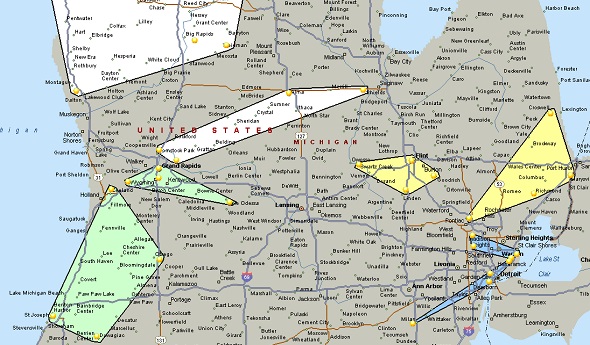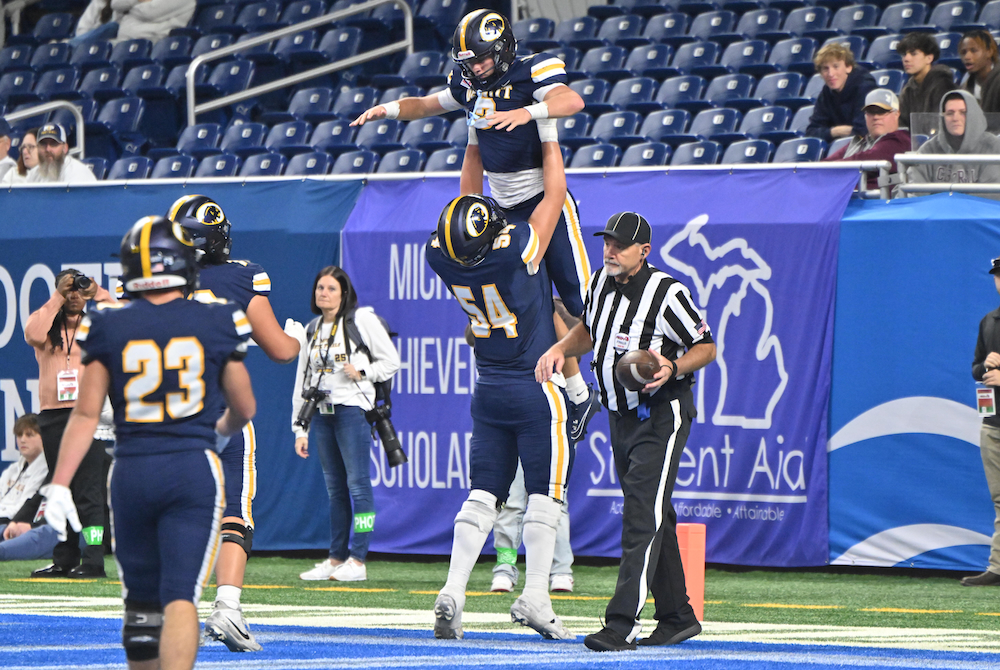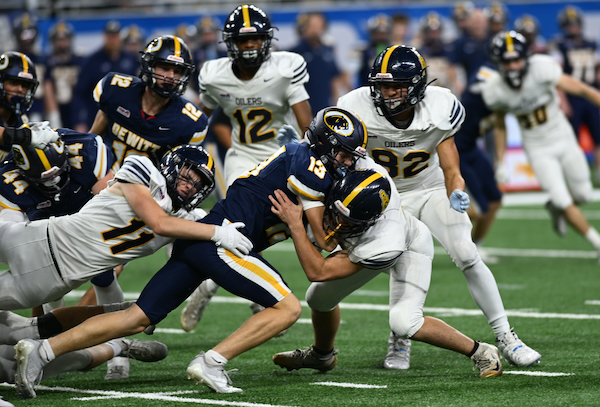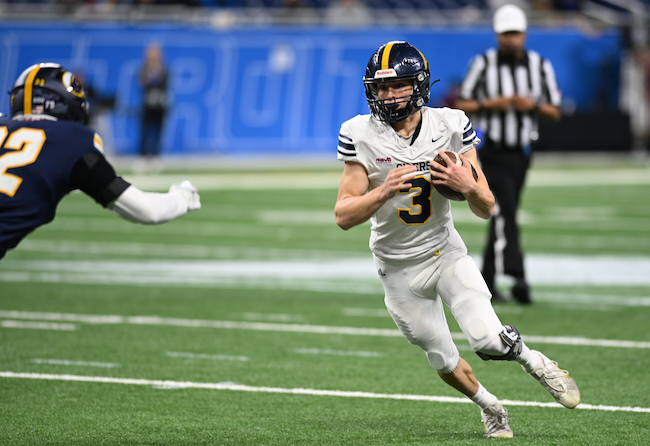
Inside Selection Sunday: Mapnalysis '15
October 26, 2015
By Geoff Kimmerly
Second Half editor
Consider that one hour Sunday night was the product of nine weeks of games on top of two more weeks of practice, hours of lifting weights, conditioning and camps and a total of six months of work at the MHSAA office, in addition to hours upon hours put in by athletic directors scheduling years in advance.
The anticipation for the release of another year's MHSAA Football Playoff pairings is matched by a giant exhale only after the results are broadcast on Fox Sports Detroit, streamed online and posted on locker room doors and Facebook walls all over our state.
 And then the fun begins again.
And then the fun begins again.
But the Selection Sunday Show is the favorite hour of the season for many fans across our state. And that’s why, for the fifth year, we’ll explain our most difficult decisions in this Mapnalysis 2015 breakdown of how we paired 272 teams that will play next month for championships across nine divisions.
For those familiar with our playoff selection process, or who have read this report in the past and don’t want a refresher on how we do what we do, skip the next section and go directly to the “Observations & Answers: 2015.” For the rest, what follows is an explanation of how we selected the playoff pairings during the morning hours Sunday, followed by how we made some of the toughest decisions and a few thoughts on the breakdown of the field.
Ground Rules
Our past: The MHSAA 11-player playoff structure – with 256 teams in eight divisions, and six wins equaling an automatic berth (or five wins for teams playing eight or fewer games) – debuted in 1999. An 8-player tournament was added in 2011, resulting in nine champions total each season.
The first playoffs were conducted in 1975 with four champions. Four more football classes were added in 1990 for a total of eight champions each fall. Through 1998, only 128 teams made the postseason, based on their playoff point averages within regions (four for each class) that were drawn before the beginning of the season. The drawing of Districts and Regionals after the end of the regular season did not begin until the most recent playoff expansion.
In early years of the current process, lines were drawn by hand. Dots representing qualifying schools were pasted on maps, one map for each division, and those maps were then covered by plastic sheets. Districts and Regionals literally were drawn with dry-erase markers.
Our present: After a late Saturday night tracking scores, we file in as the sun rises Sunday morning for a final round of gathering results we may still need (which can include making a few early a.m. calls to athletic directors). Re-checking and triple-checking of enrollments, what schools played in co-ops and opted to play as a higher class start a week in advance, and more numbers are crunched Sunday morning as the fields are set.
This season, there were a record-low 216 automatic qualifiers by win total – with the final 40 at-large then selected, by playoff-point average, one from each class in order (A, B, C, D) until the field was filled. There were only four Class D additional qualifiers with 5-4 or 4-4 (playing eight games) records from which we could choose – so after those four we added 12 teams each from Class A, Class B and Class C.
Those 256 11-player teams are then split into eight equal divisions based on enrollment, and their locations are marked on digital maps that are projected on wall-size screens and then discussed by nearly half of the MHSAA staff plus a representative from the Michigan High School Football Coaches Association. Only the locations themselves are marked (by yellow dots) – not records, playoff point averages or names of the schools or towns. In fact, mentions of those are strictly prohibited. Records and playoff points are not part of the criteria. Matchups, rivalries, previous playoff pairings, etc. also DO NOT come into play.
The same process is followed for organizing the 8-player bracket, with the difference that the 16 teams are selected purely on playoff-point average.
Geography rules: This long has been rule number one for drawing MHSAA brackets in any sport. Travel distance and ease DO come into play. Jumping on a major highway clearly is easier than driving across county-wide back roads, and that’s taken into consideration. Also, remember there’s only one Mackinac Bridge and hence only one way to cross between peninsulas – and boats are not considered a possible form of transportation. When opponents from both peninsulas will be in the same District, distance to the bridge is far more important than as the bird flies.
Tradition doesn’t reign: Every group of 32 dots is a new group – these 32 teams have not been placed in a bracket together before. How maps have been drawn in the past isn’t considered – it’s hard to say a division has been drawn in a certain way traditionally when this set of 32 teams is making up a division for the first time.
Observations & Answers: 2015
Go north with ease: For the most part, most Regional pairings were easier to draw than in past years. For the most part. Divisions 2 and 4 were not easy, specifically when it came to deciding which teams would be paired with an Upper Peninsula qualifier or a team from the Traverse City area. Keep in mind, distance on these maps isn’t based on how the bird flies, but how a bus would drive. In Division 2, that meant putting Muskegon, Muskegon Mona Shores and Grand Rapids Forest Hills Northern – near U.S. 31 and U.S. 131 – with Traverse City Central instead of sending Midland and Midland Dow west, up I-75 and then east-to-west again on more non-highway roads. In Division 4, we considered pairing Alma and Saginaw Swan Valley with Escanaba instead of Big Rapids and Remus Chippewa Hills. That decision came down to Big Rapids being about 14 miles closer to Escanaba than Swan Valley (Whitehall would go with Big Rapids and Chippewa Hills regardless.).
Four counties wide: Yes, on first glance it looks a little odd that Bay City John Glenn and Orchard Lake St. Mary’s would be in the same Division 3 District – but look at the map as a whole. Eight Division 3 teams are located south and mostly east of St. Mary’s, and John Glenn is the only team that could be considered in the northeastern quarter of the Lower Peninsula (Mount Pleasant and Gaylord are right down the middle and naturals to go with Sault Ste. Marie and Petoskey.). With the thumb playoff qualifiers of near-similar size in Division 4, there were no other options than to create this four-county trip between the Eaglets and Bobcats.
Semifinal selection: When all the Regional lines are drawn for a division, we also must figure out which Regionals will meet for Semifinals. This annually provides some challenges. Do we match east vs. west or north vs. south? If something seems iffy in four weeks when those games are played, again, keep in mind the entire map and entire Regionals that are matched up.
Scheduled strong: Because we’re looking only at dots on a map, we don’t see the matchups until everything is drawn – and in that way, we’re like everyone else. It wasn’t lost on us that two 9-0 teams will have road games this week or three 5-4 at-large qualifiers will be at home. For those 9-0 teams, it’s true: there’s nothing more they could’ve done on the field. But here’s why they will travel.
- Clinton, in Division 6, hasn’t lost a regular-season game since 2011, and in fact plays in a strong Tri-County Conference made up of Class C schools and one Class D. Four of eight from the league made the playoffs, and the competition was so strong that Morenci and Petersburg-Summerfield will host games in Division 8. But Clinton’s opponent, Monroe St. Mary Catholic Central, while it did have one loss, fell to one-loss Class B Lansing Catholic – and the Falcons played eight Class B and one Class A school this season. Beating a Class B team is worth 16 points more than beating a Class C and 32 more than beating a Class D (with those points then divided over the number of games a team plays that season) – and all of that made the difference in St. Mary’s final eight-point playoff average edge over Clinton.
- Saugatuck in Division 7 is a similar story. The Indians are one of three undefeated teams in their District, and did play a pair of Class B opponents. But by no fault of their own, especially in league play where the schedule is set, Saugatuck didn’t face a team this season that won more than five games. Hesperia played three Class B opponents including one that finished 6-3 – enough for the slim 1.8 points more in playoff average that earned the Panthers homefield advantage. Pewamo-Westphalia has the highest average in the District and didn’t play a Class B – the Pirates actually played three Class D teams. But they also beat four teams that made the playoffs including two that finished 8-1 – giving them a 2.7-point edge on Hesperia and 4.5 edge on Saugatuck.
- The 5-4 teams that will host – Redford Thurston in Division 3 and Escanaba and Benton Harbor in Division 4, all earned their spots. Escanaba faced six playoff teams and beat three, Class B Benton Harbor played eight Class A teams, and Thurston played five playoff teams and a sixth that just missed an at-large bid.
At the end of the day ...
What you see is what our committee decided upon after multiple discussions among multiple groups that broke down every sensible possibility we could muster. There are certainly points open to argument – and we likely made those arguments as well.
Those who would like to see the playoff selection process changed are in favor of a larger strength-of-schedule component, and it’s interesting to see how strength of schedule inadvertently made a larger impact this season than in the recent past – especially given the examples above of undefeated teams going on the road and at-large teams hosting.
Why were there fewer automatic qualifiers than ever before? Here's one theory. There were 11 fewer teams in 11-player football this season than in 2014 (most moved to 8-player). An argument can be made that there were fewer wins to be gained against teams that last season might have struggled to field 11-player teams, shifting the balance to fewer automatic qualifiers and more parity with stronger teams facing each other to fill their schedules.
Meanwhile, the 8-player field grew by nine teams this fall and has its strongest ever, with seven teams that finished 5-4 missing the postseason after a team with a sub-.500 record got in just a year ago.
Given how some matchups shook out this fall, the next argument by those seeking change likely will center on seeding entire Regionals instead of just Districts. But keep this in mind as well: if Regionals were seeded with this year's groupings, it would create possibilities of first-week trips like Battle Creek to Traverse City and Cedar Springs to Sault Ste. Marie. We're fairly sure most coaches and players would dread such journeys for a first-round game.
It's a lot to digest, and the scrutinizing will surely continue long after these playoffs are done as we all work to conduct the best tournament possible.
But at the end of the day – and the end of these next five weeks – to be the best, teams will need to beat the best no matter the matchups. And we’ve got plenty to look forward to starting this weekend and all the way through the 11-player Division 3 Final on Nov. 28 at Ford Field.
The MHSAA Football Playoffs are sponsored by the Michigan National Guard.
PHOTO: The Division 4 map was among the most difficult to draw during this year's selection process.

DeWitt Rewrites Finals Rushing Record Book in Completing Perfect Run
By
Scott DeCamp
Special for MHSAA.com
November 30, 2025
DETROIT – Traverse Moore had no idea about his record-setting day until the final moments of Sunday’s Division 3 Football Final.
“Honestly, I wasn’t worried about that. I was worried about getting the state championship win,” the shifty and speedy DeWitt senior quarterback said.
Moore and the Panthers left no doubt whatsoever. They ran into the history books.
On the strength of Moore’s Finals-record 397 rushing yards and four touchdowns, DeWitt rolled past Mount Pleasant, 54-20, in a battle of unbeatens at Ford Field. Moore’s effort shattered the record set in last year’s Division 6 Final by Jackson Lumen Christi’s Kadale Williams (314).
“We’ve been dreaming about it since fourth grade when we first started playing together. For this group of seniors to do that today, I couldn’t be happier,” said Moore, whose squad is the second from DeWitt to capture a Finals football title. The 2020 team won the first championship.
In DeWitt’s eighth championship game appearance, Moore scored three TDs in the opening quarter to tie a Finals record and help stake the Panthers to a 26-7 lead. The 6-foot, 195-pound Central Michigan University commit scored from 30 yards out barely two minutes into the contest, from 33 yards a little more than a minute later, and sprung free for a 74-yarder just past the midway point of the first quarter.
Moore’s fourth TD came on a 13-yard run barely three minutes into the second quarter. He had the Finals record for rushing yards early in the third quarter. He carried the ball 32 times in the game, good for 12.4 yards per attempt. Moore also completed 4 of 8 passes for 64 yards and a TD.
 As a team, DeWitt (14-0) rushed for a Finals-record 575 yards on 58 attempts (9.9 per carry). It surpassed the previous record of 549 rushing yards by Constantine in the 2004 Division 6 Final.
As a team, DeWitt (14-0) rushed for a Finals-record 575 yards on 58 attempts (9.9 per carry). It surpassed the previous record of 549 rushing yards by Constantine in the 2004 Division 6 Final.
Moore tipped his cap to DeWitt’s offensive line and tight ends, an all-senior unit comprised of Jackson Hildebrant at center, Sam VanZee and Luke Nolen at guards, Drew Rumsey and Landon Fitzpatrick at tackles, and Jacob Schorfhaar and Caleb Haman at tight ends.
“The guys up front have been special all year,” Moore said. “That’s a group of seniors that have been together since fourth grade – all of us have been together since fourth grade. They’ve been playing O-line since fourth grade, so that’s a special connection and they’re just workhorses, man.”
Sophomore Channing Ridley also reached the 100-yard plateau for DeWitt, finishing with 101 yards on 10 carries, including a 13-yard TD. Senior Jadon Bender caught a 35-yard TD pass from Moore, and junior Tyler Bashore closed out the Panthers’ scoring with a four-yard run. Bashore ended with 77 yards on 16 carries.
DeWitt piled up 219 rushing yards in the first quarter, 153 in the second, 73 in the third, and 130 in the fourth.
“In the offseason, we looked at what we had coming back,” said veteran DeWitt coach Rob Zimmerman, who completed his 27th season at the helm. “DeWitt’s probably known for being a team that throws the football around quite a bit. Last year we were physical and we threw a lot more, but with what we had coming back up front and the speed that we have, you can’t take away everything that we have.
“It’s a great combination with all the single-wing stuff that we do, which nobody else does, and so that’s an issue. But then we have the ability to run right at you and our counter game has been phenomenal for the last two years,” Zimmerman continued. “It’s a tough matchup, and then you add in the tempo, too, that we show quite a bit. I think we’re faster (in that tempo) than anybody else is as far as running plays. Put all of those things together, it’s pretty tough to stop.”
Mount Pleasant (13-1) got on the board midway through the first quarter on a 31-yard TD pass from junior Xavier Creguer to senior Riley Olson. Creguer added a four-yard scoring run with 12 seconds remaining in the first half, but the Oilers were still facing a 40-14 deficit headed into the halftime break.
Creguer joined Moore in the record books with his 91-yard TD run in the third quarter – longest in Finals history, surpassing 90-yard scoring runs by Edwardsburg’s Nick Bradley (2017) and Farmington Hills Harrison’s Nick Williams (1994).
It was an uphill battle for Mount Pleasant, which made its second Finals appearance and still seeks its first championship.
 “I wonder if a little bit of the bright lights got to us to start with. We made a few mistakes from the start … . Just a few, little things that we’d like to have back,” Mount Pleasant coach Jason McIntyre.
“I wonder if a little bit of the bright lights got to us to start with. We made a few mistakes from the start … . Just a few, little things that we’d like to have back,” Mount Pleasant coach Jason McIntyre.
“That’s a tremendous DeWitt team. It would have been really difficult to hang up the middle, but I think you saw what we could have done maybe if we would have been able to start a little fresher, a little cleaner. … Their offense is super difficult to defend. I thought we were well-prepared in terms of alignment, but the speed in which they do it and obviously No. 2’s (Traverse Moore) a really good player.”
Creguer finished with 162 rushing yards on 12 carries. He also threw for 66 yards.
Senior William Garcia led all defenders with 11 tackles for Mount Pleasant, while Olson notched 10 stops. Senior Lucas Brandell recorded a team-high six tackles for DeWitt.
DeWitt lost in last year’s Semifinal to eventual champion Zeeland West, 32-20. That defeat lingered with the Panthers and fueled them for this season’s run to glory.
“I mean, that stung. Last year stung. It hurt,” DeWitt senior Miller Wing said. “But when winter lifts rolled around, 5:45 in the morning, that’s the reason for it. It’s just staying together as a team. We’re so close.”
DeWitt has been a perennial contender in Division 3. The Panthers have advanced to the Semifinals or further seven of the last eight seasons.
According to Zimmerman, it’s all about the culture, establishing expectations, and putting in the work.
“The older kids have always helped our younger guys to understand the expectations within the program, and I think that’s a big part of why we’re where we’re at as a program,” Zimmerman said. “These guys want to be the next dude, and they work to get there.
“Ton of similarities (between the two championship teams) from a toughness standpoint, leadership standpoint, work ethic. I mean, these guys put in an unbelievable amount of time in the offseason to get where they’re at. This class, from sophomore (season on up), they’re 35-1 as a class, so it’s a pretty good group.”
PHOTOS (Top) DeWitt’s Sam VanZee (54) hoists teammate Traverse Moore into the air in the end zone Sunday. (Middle) Landon Kurncz (13) attempts to surge ahead with Mount Pleasant’s Keagan Wernette-Beals (11) and another defender wrapping him up. (Below) The Oilers’ Xavier Creguer prepares to take on a DeWitt defender.

